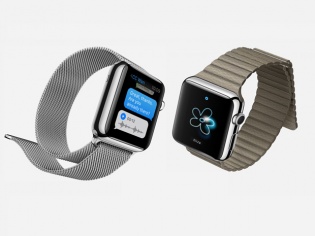-
Chandrakant 'CK' Isi
12th Sep 2014
Many a times, innovations are driven by popular culture. Take for instance, smartwatches. Authors and film-makers had envisioned a watch that can perform complex tasks such as wireless calls, data connectivity, and whatnot. Imagine this, when even cellphones were a distant dream. Thanks to Television, movies, and books, people got to see such concepts. Especially, Dick Tracey, and even Star Trek made this idea very popular.

While most of these were just wild ideas, the legendary Director, Stanley Kubrick, known for incredible attention to detail, decided to build believable gadgets for his movie 2001: A Space Odyssey. Kubrick approached Hamilton to build futuristic time piece. After this movie project, the company took the electronic watch program seriously.
Finally, in 70s Hamilton showcased first electric watch to the world. Dubbed Pulsar Limited Edition this was had an LED display (not to be confused with LED LCD). Similar to the recently released Apple Watch, it came in 18 karat gold version.

Seiko D409
Casio started building calculator and gaming (yes) watches that became a rage in 80s. It was a must have gadget for kids in that era. On the other hand, Seiko had studious folks covered. Its D409 watch was probably the world's first smartwatch as it featured a few bits of onboard memory and a Dot Matrix touchscreen LCD. That was unbelievably high-tech for that time.IBM WatchPad
Near the end of 90s, Steve Mann built an open-sourced Linux wristwatch platform (take that Android Wear). Little wonder then, Steve is rightly known as the father of wearable computing. In 2000, IBM partnered with Citizen to build the WatchPad based on Linux platform. The gadget had an LCD screen with 320x240 pixels. It also had relatively modern features such as Bluetooth and accelerometer.
Fossil Wrist PDA
Year 2003, witnessed the launch of the Fossil Wrist PDA. based on Palm OS, this smartwatch featured a touchscreen with handwriting recognition (stylus included). Inside was a 66 MHz processor from Motorola. Apart from syncing data, its Infrared port could be programmed to work as a TV remote. With all these features, its battery watch-face mode the battery life is around 1-2 days, depending on the integrity of the battery.
Microsoft SPOT
A year later, software behemoth Microsoft introduced its SPOT (Smart Personal Object Technology) platform. Watchmakers Fossil, Tissot, and Swatch built a few watches using this OS. These were first truly connected watches that received data over radio waves. Users had access to information such as stocks, weather, sports and whatnot. The yearly service subscription was $60.
Samsung S9110
Come 2009, Samsung unleashed its S9110, which is undoubtedly one of the ugliest watch ever made. The gadget features a 1.7-inch 256 colour touchscreen. It was based on Samsung's in-house software. This smartwatch had 40 MB internal storage that could hold a few MP3s. More importantly, it had a cellular calling facility. Plus, you could access emails using GPRS data connection.
Sony Smartwatch
The Japanese brand Sony released its Smartwatch (MN2SW) in 2010. The gadget works as a companion to your Android smartphone. Using Bluetooth, it pulls data from your phone, and displays it on its 1.3-inch capacitive OLED screen. Plus, you can also use it to control media playback on your handset.
Pebble
Result of a successful crowd funding campaign, the Pebble smartwatch hit the market last year. The timepiece sports an e-ink (monochrome) display with 1 bit graphics. It feature four hardware buttons for input. The watch is compatible with Android and iPhones. Similar to Sony's gadget, the Pebble Alerts include incoming call, SMS, iMessage, calendar, Facebook messages and Twitter.
Android Wear
After the massive success of its Android smartphone platform, Google brought its popular OS to smartwatches. Manufacturers such as Motorola, LG, and ASUS quickly embraced this software to power their wearables. Android Wear devices will be compatible with handsets running version 4.3 and above. The UI is designed in a way that it supports both round and rectangular watches. The most famous product among the first wave of Wear devices is Moto 360.
Apple Watch
Apple is known for polished products and its Watch is no exception. Undoubtedly, it's one of the best looking smartwatch ever made. Apart from the touchscreen, it uses the digital crown for menu navigation. When connected to your iPhone, the Watch can notify you about the incoming calls, text, and alerts. You can answer or make calls from the Apple Watch (provided that it's connected to your iPhone). The Watch also works as a fitness band.
The History Of Smartwatches: From Seiko To Apple | TechTree.com
The History Of Smartwatches: From Seiko To Apple
Find out how companies changed the way we look at time.
News Corner
- DRIFE Begins Operations in Namma Bengaluru
- Sevenaire launches ‘NEPTUNE’ – 24W Portable Speaker with RGB LED Lights
- Inbase launches ‘Urban Q1 Pro’ TWS Earbuds with Smart Touch control in India
- Airtel announces Rs 6000 cashback on purchase of smartphones from leading brands
- 78% of Indians are saving to spend during the festive season and 72% will splurge on gadgets & electronics
- 5 Tips For Buying A TV This Festive Season
- Facebook launches its largest creator education program in India
- 5 educational tech toys for young and aspiring engineers
- Mid-range smartphones emerge as customer favourites this festive season, reveals Amazon survey
- COLORFUL Launches Onebot M24A1 AIO PC for Professionals







TECHTREE